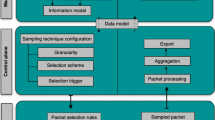Abstract
Aggregated traffic traces are commonly used in network engineering for QoS or performance parameters evaluation. Many performance models come from such aggregated traces. However, real traffic is a marked point process combining two processes: one for the arrival times of packets and the other for their size in bytes. This paper deals with assessing whether aggregated traces are a good representation of real traffic. Based on the analysis of many traffic traces, and focusing only on loss probability, it is shown that the packet drop probability obtained for the aggregated traffic traces can significantly differ from the real packet drop probability obtained for the real traffic traces. Then, a solution which enables one to obtain correct loss probability based on aggregated traffic traces is proposed by determining the correct aggregation scale and traffic parameters to be applied.
Similar content being viewed by others
References
Akaike, H. (1974). A new look at the statistical model identification. IEEE Transactions on Automatic Control, 19(6), 716–723.
Bhattacharyya, S., Diot, C., & Jetcheva, J. (2001). Pop-level and access-link-level traffic dynamics in a tier-1 pop. In IMW ’01: proceedings of the 1st ACM SIGCOMM workshop on Internet measurement (pp. 39–53). New York: ACM.
Box, G. E. P., & Jenkins, G. M. (1976). Time series analysis: forecasting and control. San Francisco: Holden-Day.
Cleary, J., Donnelly, S., Graham, I., McGregor, A., & Pearson, M. (2000). Design principles for accurate passive measurement. In PAM2000 passive and active measurement workshop (pp. 1–7), May 2000.
Crovella, M., & Bestavros, A. (1996). Self-similarity in world wide web traffic: Evidence and possible causes. Performance Evaluation Review, 24(1), 160–169. Also, in Proceedings of SIGMETRICS’96: the ACM international conference on measurement and modeling of computer systems, Philadelphia, Pennsylvania, May 1996.
Fraleigh, C., Moon, S., Lyles, B., Cotton, C., Khan, M., Moll, D., Rockell, R., Seely, T., & Diot, C. (2003). Packet-level traffic measurements from the sprint ip backbone. IEEE Network, 17(6), 6–16.
Garrett, M. W., & Willinger, W. (1994). Analysis, modeling and generation of self-similar VBR video traffic. In SIGCOMM (pp. 269–280).
Janowski, L., Ziegler, T., & Hasenleithner, E. (2006). A scaling analysis of umts traffic. In NEW2AN (pp. 211–222).
Leland, W. E., Taqqu, M. S., Willinger, W., & Wilson, D. V. (1994). On the self-similar nature of Ethernet traffic (extended version). IEEE/ACM Transactions on Networking, 2(1), 1–15.
McCullagh, P., & Nelders, J. (1991). Generalized linear models (2nd edn.). London: Chapman & Hall.
METROSEC (2005). Metrology for security and quality of service. http://www.laas.fr/METROSEC/.
NIST (2002). NIST/SEMATECH e-handbook of statistical methods. http://www.itl.nist.gov/div898/handbook.
NLANR (2003). Measurement & network analysis, Auckland-VIII. http://pma.nlanr.net/Special/auck8.html.
Norros, I. (1994) A storage model with self-similar input.
Packet statistics for Auckland-VIII 20031209, 2003. http://pma.nlanr.net/Special/auck8/20031209-p.html.
Park, K., & Willinger, W. (2000). Self-similar network traffic and performance evaluation. New York: Wiley.
Prasad, R. S., Dovrolis, C., & Thottan, M. (2007). Router buffer sizing revisited: the role of the output/input capacity ratio. In J. Kurose & H. Schulzrinne (Eds.), CoNEXT (p. 15). New York: ACM.
Scherrer, A., Larrieu, N., Borgnat, P., Owezarski, P., & Abry, P. (2007). Non-Gaussian and long memory statistical characterisations for Internet traffic with anomalies. IEEE Transactions on Dependable and Secure Computing, 4(1), 56–70.
Sheluhin, O., Smolskiy, S., & Osin, A. (2007). Self-similar processes in telecommunications. New York: Wiley.
The R project for statistical computing. (2008). http://www.r-project.org/.
Troubleshooting output drops with priority queueing (August 2005). http://www.cisco.com/warp/public/105/priorityqueuedrops.pdf.
Wang, Z. (2001). Internet QoS—architecture and mechanisms for quality of service. San Mateo: Morgan Kaufmann.
Author information
Authors and Affiliations
Corresponding author
Rights and permissions
About this article
Cite this article
Janowski, L., Owezarski, P. Assessing the accuracy of using aggregated traffic traces in network engineering. Telecommun Syst 43, 223–236 (2010). https://doi.org/10.1007/s11235-009-9210-9
Published:
Issue Date:
DOI: https://doi.org/10.1007/s11235-009-9210-9




